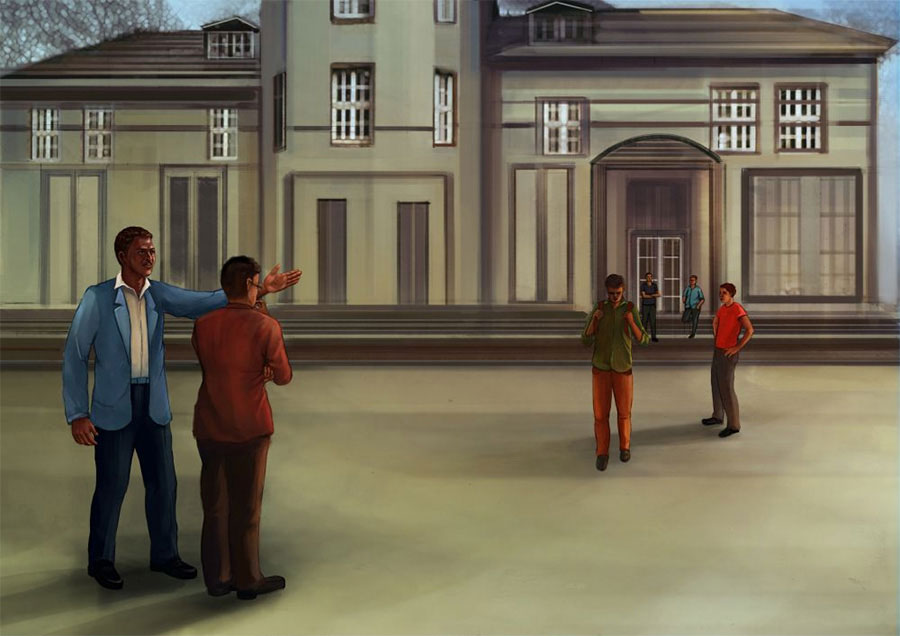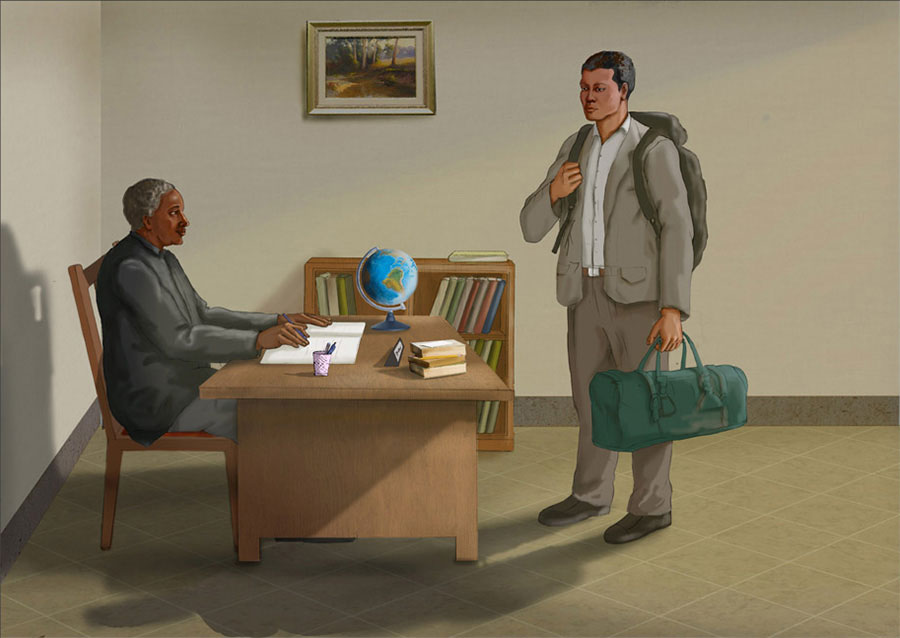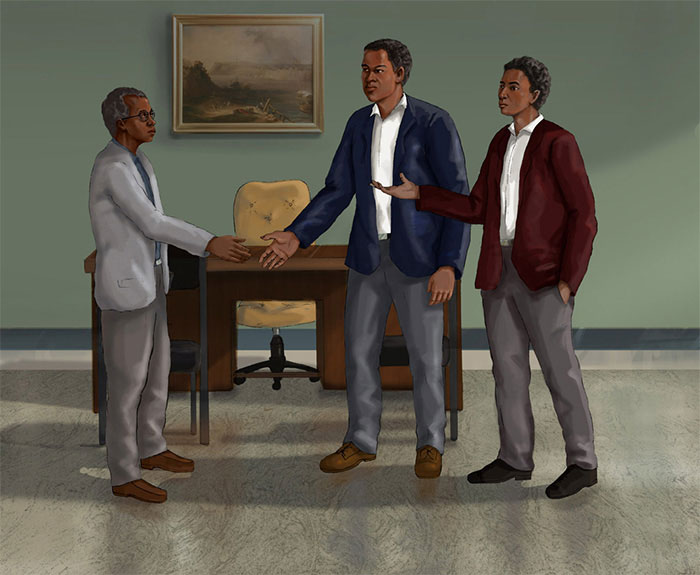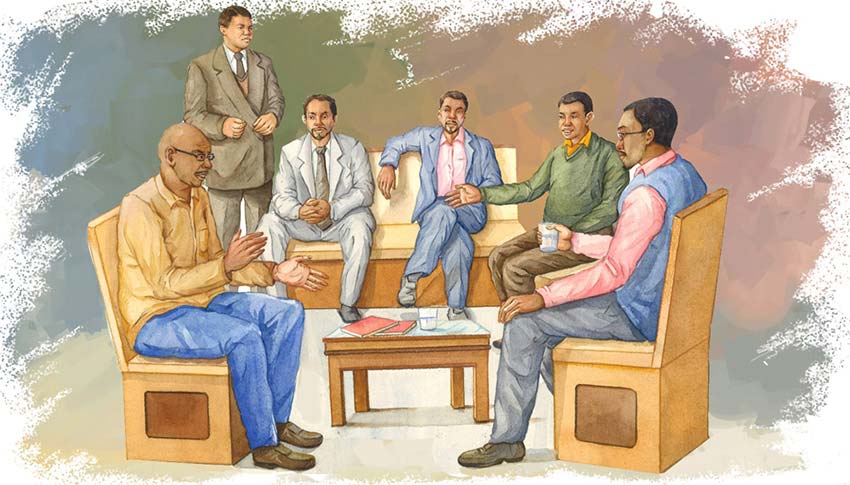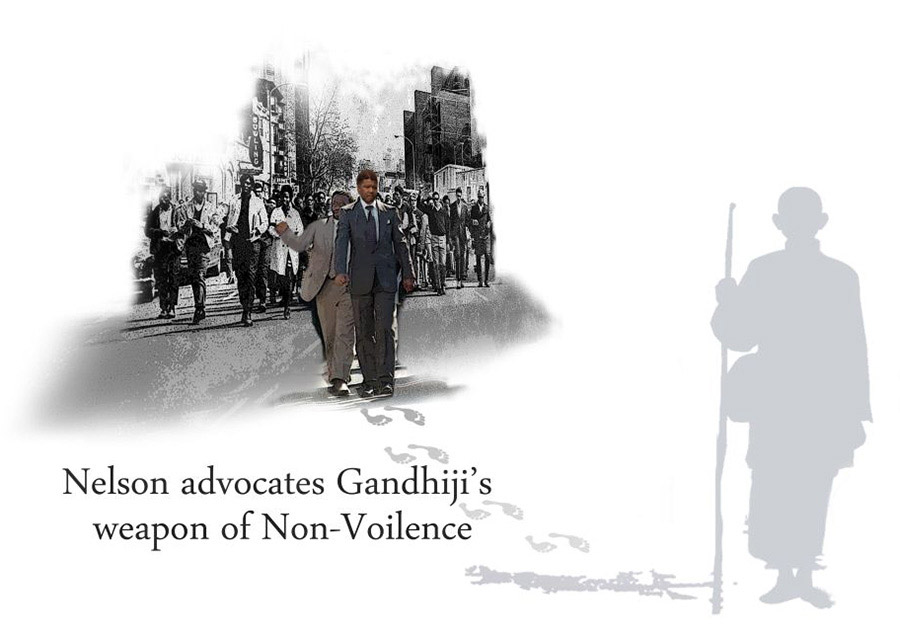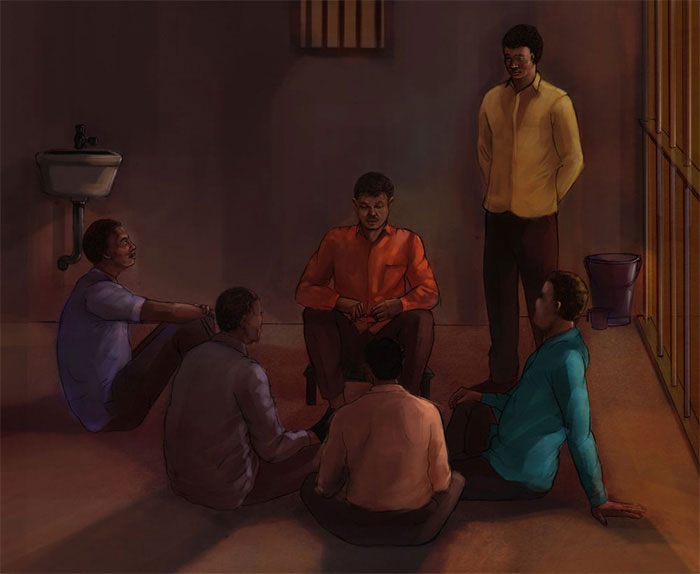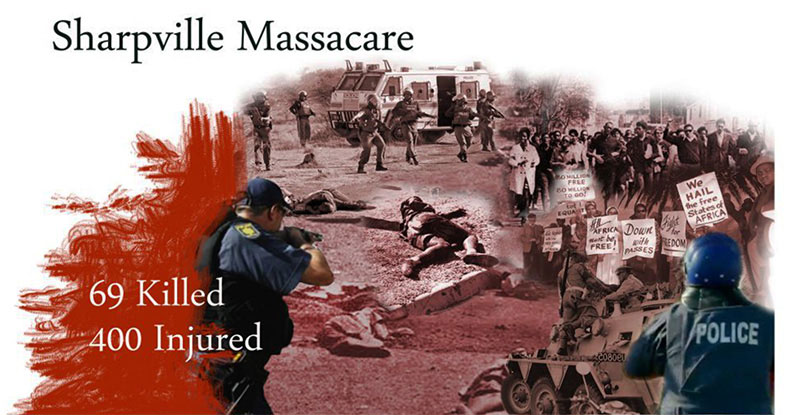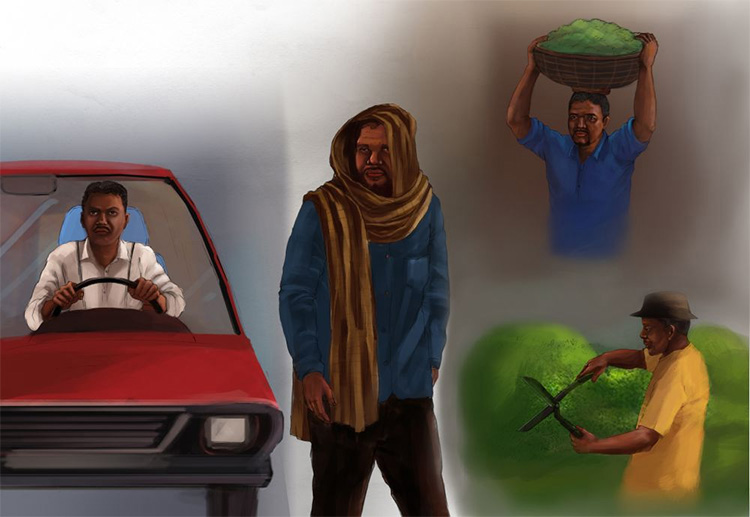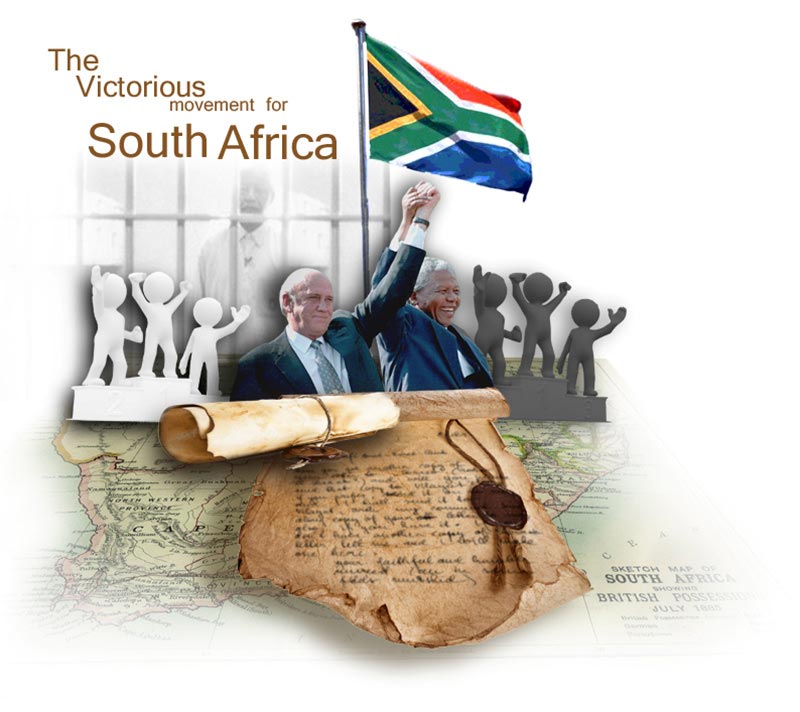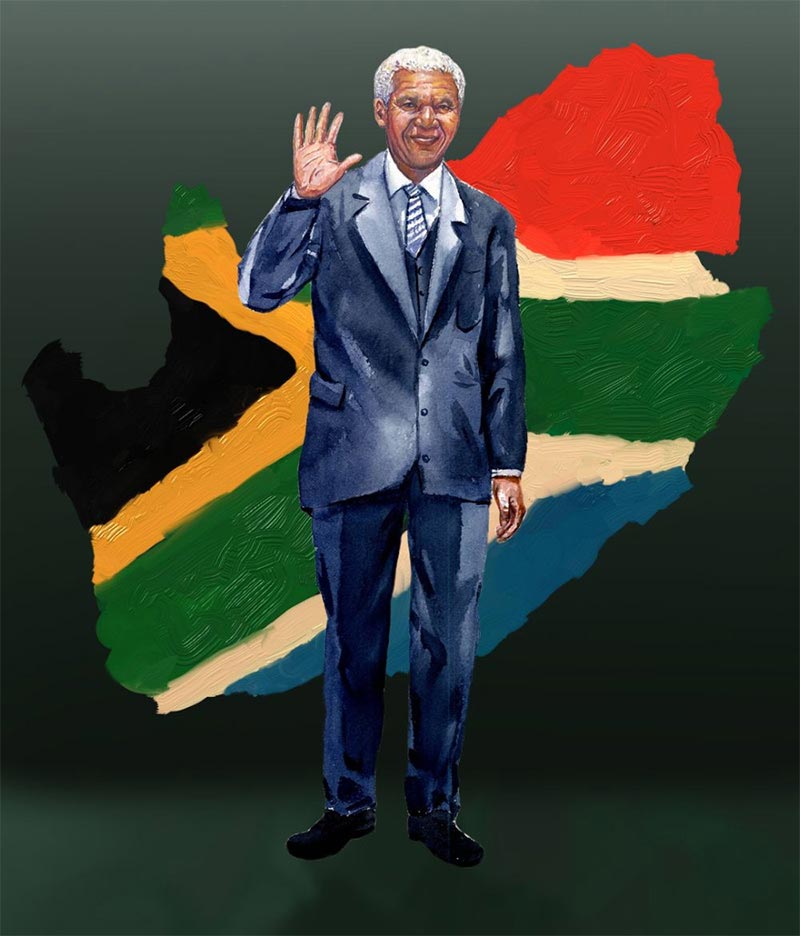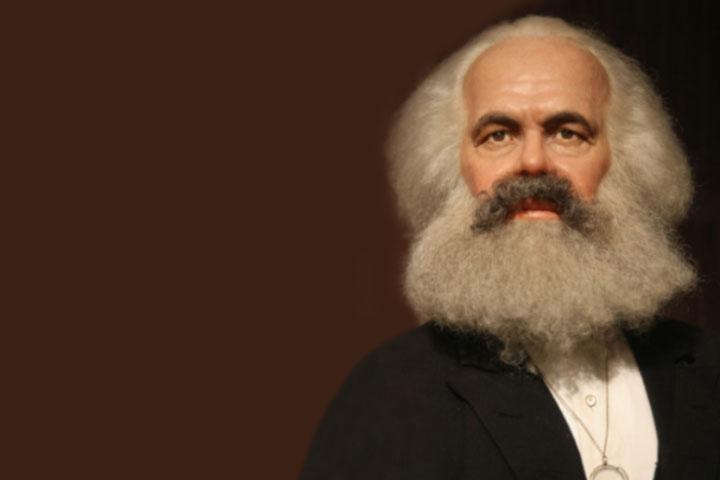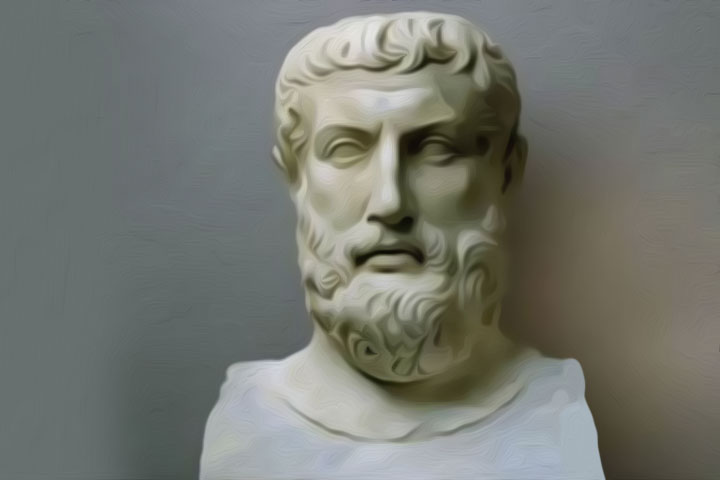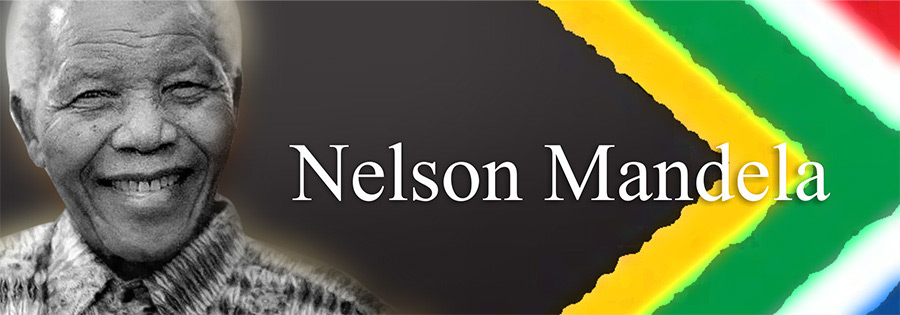
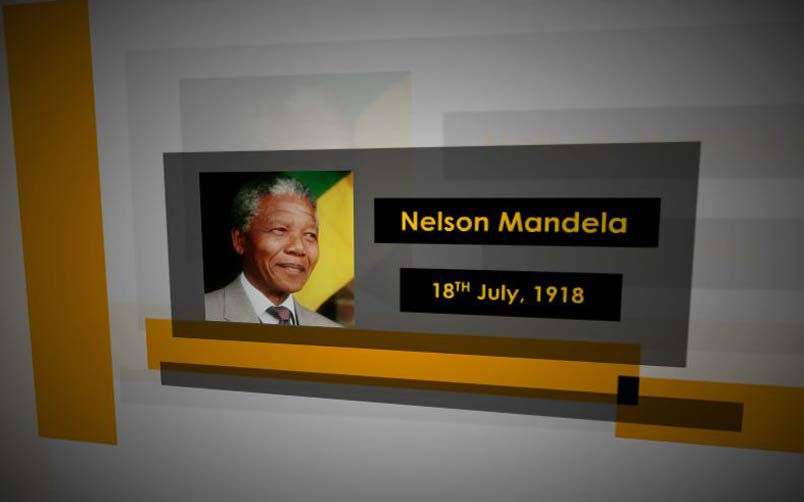
Introduction
In Distinctively Extraordinary
As people of South Africa switched on their TV sets on the afternoon of 10th May, 1994, they became the witnesses to the ceremony that became a timeless milestone in the history of South African politics. The man who stood behind the podium after his oath as the president, addressed his countrymen and said, “Take your knives and your guns and your pangas and throw them into the sea. Never… Never… and never again shall it be that this beautiful land will again experience the oppression of one by another and suffer the indignity of being the skunk of the world.” These words of immense strength and glory came from a man who was resolute and determined to stand for his rights in the most adverse of situations. Nelson Mandela, the man behind the revival of South African republic, is the icon of moral conduct. He was the longest detained political prisoner of the world, who after his release, went on to become the first Black President of an independent nation. He is the most high-spirited, most unbending and the most defiant leader of all times. He is the preacher and practitioner of indulgence in community betterment and selfless service to the nation.
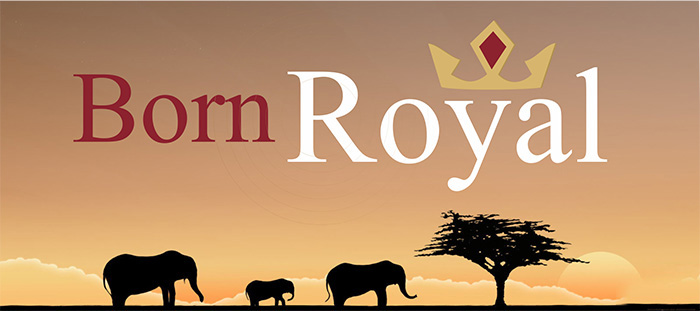
Born Royal
It all started on July 18, 1918, when a little boy named ‘Rolihlahla’ was born in a Thembu tribe household to Gadla Henry Mphakanyiswa and Nosekeni Fanny. Nelson Mandela was bestowed upon with a very primitive and thoughtful birth name, ‘Rolihlahla’, which literally means ‘trouble maker’ in English. His life started taking shape in Mvezo, in the state of Umata, Eastern Cape of South Africa. Mvezo was a precinct in Transkei and Umata was its capital. Mandela’s father, Henry was a royal chief, both by blood and custom. By blood, he was the descendent of the royal family of the Thembu tribe and by custom, he was confirmed as the ‘local magistrate’ by the prevailing British Rule.
Mandela was Henry’s son from his third wife. Being a chief, he had the privilege of getting married to four women, each of whom belonged to different clans of Xhosa- the superseding nation of the Thembu tribe. Mandela was the eldest of the children from Fanny- the third wife and the youngest of the four sons from all four wives. During the time when Mandela was still a new born child, his father was deposed from the Chieftainship as the local magistrate. He had defied the higher grade magistrates and such a deed was not expected of the blacks during those times. Mandela always recalls of having inherited his rebelliousness and that stubborn sense of fairness from his father. In the early 1920’s when he was still a small boy, things that happened as an aftermath of that deposition led a new course of life for Mandela in Qunu, a slightly larger village in the north of Mvezo.

Living the Ordinaries
While in Qunu, life did not have much to offer and Mandela always found peace in whatever surrounded him. At the age of 5, in 1923, he became a herd boy looking after the cattle and fields. He says that the Xhosa has always been attached to their cattle not just as a source of their livelihood and food but also as a blessing from God and a source of happiness. He dates his love for natural beauty, open spaces and never ending lines of horizon to these days. He lived the most innocent and rightful childhood. Children made their own toys which they molded out of clay and all the trees and rivers were their playing hubs. As far as education was concerned, the Xhosa children were supposed to learn by observation. His father was also illiterate, but he was one of the most intelligent chiefs of Mvezo. For Mandela, the prevailing customs, rituals and taboos were his only teachers. He knew, that the path laid down by the ancestors was the path that is set for them to follow and any question in that context raises brows, creates nuisance and brings disharmony and ill-fortune.
During the British reign, there were many African households who got converted into Christians and were leading lives differently than the normal crowd. While they became gruesome for most of the normal blacks, Mandela’s father had a different opinion. He considered it only fair to be baptized and migrate to the more advanced section of the community. As a result, Mandela was baptized into a Methodist or the Wesleyan Church as it was known then. A family friend of Mandelas, Mbekela Brothers, who were amongst the first black families to get converted, suggested Henry that his son was exceptionally bright and should not be deprived of the elementary education at the missionary school. The fact struck to his father clearly and he immediately decided that Mandela would indeed go to school. On the first day of the school, as a ritual, all the baptized children were rendered a new English name for the ease of pronunciation and recognition. The first name that preceded Mandela now changed from ‘Rolihlahla’ to ‘Nelson’. On the first day of his school, he became Nelson Mandela.
In 1927, when Mandela was 9 years old, his father died of acute chronic cough. As a result of his father’s demise, Mandela and his mother had to pack their bags again and depart from Qunu. The place they were about to go had a lot in store for young Mandela, most of which he was unaware at that instance. Years later, whenever Mandela retrospects his father’s death, he has said, “it had changed my whole life in a way that I did not suspect at that time.” During that time, as a 9 year old, what hurt Mandela more was the idea of leaving behind his beloved native village Qunu. He was more sad for this loss than the former. But the next chapter of his life was much more fascinating and engaging.
When Mandela first reached Mqhekezweni, he was totally amazed by the grandeur and mammoth lifestyle of the people staying there. He and his mother were visiting the royal residence of Chief Jongintaba Dalindyebo, who was at that juncture the acting regent of the Thembu tribe. After the death of his father, Mandela became the ward of the regent Jongintaba and this was the occasion of them getting formally acquainted to each other. Jongintaba had a slender personality but he carried himself with a sense of pride and authority. He commanded the respect from his tribe that he rightly deserved for his confidence and bearing.
Later on, Mandela was left by her mother under the guidance and care of the regent. Although different and tedious, life in Mqhekezweni was much like an adventure for him. While on one hand he was keeping up with his pre-requisite education at school, on the other, he was also being trained as a plough boy, wagon guide, shepherd and horse rider. As a young boy, the absence of his mother used to daunt him at times but nonetheless, he used to get over it quickly because of his jam packed schedule at the regent’s house. Besides, the regent and his wife used to treat Mandela as their own child. He was raised with complete fairness and was given equal rights and liberty as their own son Justice. Justice, who was the regent’s real son, was 4 years older to Mandela. He was precisely Nelson’s first hero after his father. He became a role model for juvenile Mandela in every sense of the term. To him, Justice used to be this well groomed extroverted person, who swiftly got a hold of things, while he himself always had the image of a shy and serious boy. He was fondly referred to as ‘Grandpa’ by the regent’s family due to his serious, old man look.
Life in the coming few years was pretty much the same for Mandela. He had grown accustomed to performing the daily errands and listening to the Thembu history being spoken by various chiefs and headmen who came to visit the regent seeking justice in their respective trials. In the year 1934, when Mandela was 16, the regent decided that now was the perfect time for him to undergo the transformation from a boy to a man. This was the time for his ‘circumcision’. Circumcision was not a surgical process but it was more of a ritual, a one of its kind and an elaborate ritual for that matter.
After becoming a man as they referred to it, Mandela was sent to Clarkesbury Boarding Institute in the district of Engcobo. After the regent bade good bye to Mandela, new doors and horizons opened for him. He knew that this place and experience were going to be different for him. He soon discovered and got habituated to the fact that in Clarkesbury he was not the only one to have inherited distinguished lineages. He also realized that it was only his ability and dedication that could change his standing in this newly found approximation of home. And keeping up to the expectations and pride of the regent was always a constant motivation for him. It was here that he had his first experience of racial discrimination. In his autobiography, when Mandela speaks about the experience at Clarkesbury, he says “no matter how high a black man advanced, he was still considered inferior to the lowest white man.” But being diligent and sharp by birth, Mandela never had a problem catching up with the lessons and other things as well. In fact, he completed his program in two years itself instead of the usual three years tenure. Everything earned and achieved; the perception that still remained unchanged for Mandela while parting from Clarkesbury was that Thembuland was the greatest place to be and being a Thembu was no less than destiny’s fortune.
When Mandela turned 19 in 1937, he was sent to Healdtown, the Wesleyan College in Fort Beaufort in Umata, following the family tradition. He joined Justice, the regent’s son who was already enrolled there. While in Healdtown, Mandela experienced a tough and rigorous life. But nevertheless, he was progressing. He became a much better sportsman in Healdtown than he was in Clarkesbury. He tried his hand at long distance running and boxing. He even became a prefect in the second year of his education. The next ladder that was set forth for Mandela to climb was Fort Hare. For the young blacks during that time, fort Hare was equivalent to Cambridge and Oxford. Both regent and Mandela were skeptic and cross-fingered for latter’s acceptance there. Finally, after successfully clearing the interview at Fort Hare, Mandela at 21 years of age, started his academics for the university degree of BA. The only thing that clouded his mind as a youth of the nation deprived of humanity and moral equality was to reach up to the office level and become a civil servant. He once said,“A good head and good heart are always a formidable combination. But when you add to that a literate tongue or pen, then you have something very special.”As a boy advancing towards manhood, he lived and breathed this thought.
Although remaining under the grip of the whites was what the blacks had to do at that time, still, a jolt of strength and valour was experienced by Mandela when he had his first experience of standing up against the laws. Fort Hare seniors had the policy of keeping the freshmen year students from being a part of the House Committee, which was unacceptable to the freshers. Mandela being one of the latter felt that the college authorities should know about the undue supremacy of the senior students. The matter was brought forth to the college management and the freshmen students got the final decision in their favour. This first battle against the status-quo ignited the feeling of confidence in Mandela which made him strive more and more for justice and equality in the years to come.
Fort Hare was no different from Healdtown as far as Mandela’s academics and progressive co-curricular involvement were concerned. At Fort Hare, he mastered both soccer and cross country running, perfected ball room dancing and became a member of the Students Christian Association. It was through this association that he befriended Oliver Tambo- his non-conformist, soccer playing comrade. Oliver and Mandela had met before during the classes and the sports hours, but these community service initiatives actually gave them time to bond and know each other better. During this educational journey, Mandela broke some notions and consolidated some others. He understood the right and need to stop the injustice and humiliation being done to the blacks. During his entourage by one of his cousins Paul Mahabane, he discovered that he need not succumb to anything or everything that a white says to a black. Simultaneously, on the other hand, his belief regarding the importance of a university degree and it being the sheer mantra of success was getting more strengthened.
What happened in the second year of Fort Hare was something that nobody, not even Mandela had foreseen. A person, who considered this BA degree to be imperative for his entry into the real world, chose to quit his education solely due to his ethics and morale. He had been elected as the nominee for the elections of the student’s council at Fort Hare, but as a matter of principle, he boycotted this election due to the pile of unheard grievances of students. Since this deed was a pure act of rebellion as per the university norms, he was presented a choice by the dean to either accept the nomination or get dismissed from the university. After a whole sleepless night of contemplation, Mandela walked in the dean’s office next morning with his bags packed, ready to leave the institution.
This step was crucial in Mandela’s life as it was here, that he overlooked his own prosperity for the betterment of the whole. In the years to come, this step would have its repercussions- both good and bad, but yet again, we are going ahead of time!!
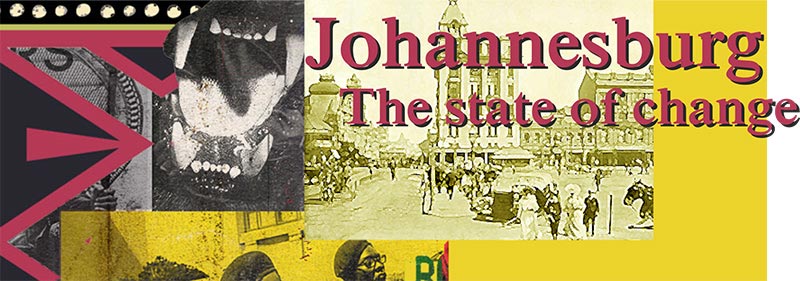
Johannesburg- The state of change
Returning to Mqhekezweni was never so difficult for Mandela. But this time, it was different for two main reasons. One, he had defied the college laws and was dismissed and two, he had to explain this situation to the regent. As expected, the regent went furious when he heard about the rebellion that Mandela had ignited at Fort Hare. He opined that after the completion of the running semester, Mandela would be sent back to the university and he would not challenge or argue any of the university norms thereafter. The path was set and no discussion was invited and as Mandela waited for the autumn to end, he became accustomed to the daily chores in Mqhekezweni again. During this time, Mandela got united with Justice again after a long time. Both the brothers had lot to share and talk and thus time went flying by until that one evening when both of them were called by the regent. That evening of 1939 was a peculiar one when regent had invited both his boys to inform them that he had arranged marital alliances for them. The news took both of them by shock. Neither Justice nor Mandela was ready for any sorts of tied ends at that point of time. After hearing the final words that came out of the regent’s mouth, both of them were pretty sure that they did not have any say in this matter and no pleading or discussion would prove fruitful. To them, the only option available at their altar was escape. Both of them packed their essentials and went en route for Johannesburg.
Until the day Mandela had seen Johannesburg, the only place that appeared grand and mighty to him was Mqhekezweni. But stepping in Johannesburg broke this illusion too. The life, the city, the people, everything was on a move in this city of opulence. Immediately after reaching Johannesburg, Justice and Mandela devised some alternatives and started working. Mandela took up the job of a night guard in the Gold mines. The initial days of their stay in the city were joyous and fulfilling. Both of them had enough money and jobs that were seemingly permanent. But it did not take long for them to find themselves with reversed fortunes. One unkindly encounter when the duo was boasting about their rebellion and non-conformism to their fellow worker changed their entire course. The friend who had now known that the boys had escaped from their home against the regent’s wish, confided in the mine owner regarding the same. It did not take much time for the owner to kick Justice and Mandela out of their respective jobs.
After facing a tough time for the coming few months, both Justice and Mandela found their respective paths and started working for the same. Mandela had by that time shifted with his cousin Garlick Mbekeni in George Township. Garlick who was a hawker by profession, had a kind and empathetic heart. Just after a few weeks when Mandela confided in him about his wish of becoming a lawyer, he arranged for a meeting with one of the most influential people in Johannesburg. When Mandela first met Walter Sisulu he only observed the agility and confidence of the young man who appeared to be in his late twenties.
Although he was a black, the man had impressive eloquence in the English language and was quite experienced for his age. Walter Sisulu was a prominent name in Johannesburg. He was a progressive businessman and a local leader too. Mandela had told Sisulu about his aspiration of becoming a lawyer and Sisulu confidently appeased him by saying that he would find a good place for him in the days to come. Things were getting sorted for Mandela slowly and steadily. He had moved to the Alexandra Township under the landownership of Mr. Xhoma, who was one of an elite handful of African landowners in Johannesburg. In the meantime, Sisulu had also secured a place for Mandela in a leading law firm ‘Witkin, Sidelsky and Eidelman’. He was registered in this firm as a law article, but for him to get formally certified as an article, he needed a BA degree which he had quit in Fort Hare. So, he applied for the correspondence educational BA degree with UNISA (University of South Africa) and after this, life for Mandela was on rails! He was graduating as a BA and working as a law article with the biggest law firm in the city.
Mr. Sidelsky who was one of the founders of this giant law firm and also Mandela’s immediate boss, was a highly respected man in his mid-thirties. He took a genuine interest in his prodigy’s learning and grooming. Initially, the work was pretty elementary for Mandela but as the tenure of his articleship progressed, he became more and more familiar with the functioning of the real world. Soon, he came over another one of his long held beliefs regarding the exiguity of one being highly qualified, for here, he witnessed people with qualifications as paltry as grade six serving at the most convoluted and challenging posts in various firms. One such co-worker was Gaur Radebe, the trouble maker in ‘Witkin, Sidelsky and Eidelman’. He was an active member of the ANC (African National Congress) and Communist party when Mandela had his first introduction with him. Gaur was a man of great disposition. He never treated any employer with crawling supremacy or courtesy which was the common code of conduct for most of the articles back then. Although Mandela used to find Gaur intriguing and influential, Mr. Sidelsky always advised him to maintain a fair distance from the latter. To Mr. Sidelsky, Gaur and Walter Sisulu were nothing more than crude politicians and fanatics who, if not discouraged, would eventually pollute Mandela’s focus and dedication and divulge his interests to politics. Although Mandela never intended to exasperate his mentor, he could not resist being driven to Gaur’s ideology. While working at this firm, he befriended others who supported Gaur’s conviction and he could not help but become a part of that crowd. Time passed by and with every passing day, Mandela was rediscovering himself in some or the other way.
It was in the trails of the year 1941 that Mandela received a word that the regent was visiting Johannesburg and was eager to meet him. Though nervous, but even Mandela wanted to take this opportunity to reconcile his deeds in front of the regent. Unlike what he had expected, the regent’s behavior was tender and fatherly. He enquired about the former’s well being and blessed him for prosperity. Meeting his father like guardian after a long time made Mandela more confident of the path he had chosen for himself. But as they say, good things do not last long. In not more than six months of this rendezvous with the regent, Mandela found out through an article published in the local newspaper, that the regent was no more.
Besides this irreplaceable loss, another major occurrence during the year 1942 was that by the year end, Mandela had passed his final exam for the BA degree, which until a few countable months ago was the only reason for Mandela to strive so hard. But when he finally did become a BA, his thoughts were no more in alignment with his long lost dreams. He has shared his experiences of the changed life in Johannesburg in his biography where he says, “My life in Johannesburg, my exposure to men like Gaur Rabede, my experiences at the law firm had radically altered all my beliefs.” As time went by, Mandela became more and more involved with Gaur and his social activities. He started attending the meetings of the Township Advisory Board and the ANC with Gaur, but all this was passive with little or no participation from his end. However, he enjoyed being a listener to the lively debates and discussions at the ANC meetings.
By the beginning of 1943, he had returned to Johannesburg to start with his Bachelors in Law at the University of Witwatersland. It was in this institution that Mandela came across some of his lifelong friends and companions like Joe Slovo, Ruth Slovo, George Bizos and others.
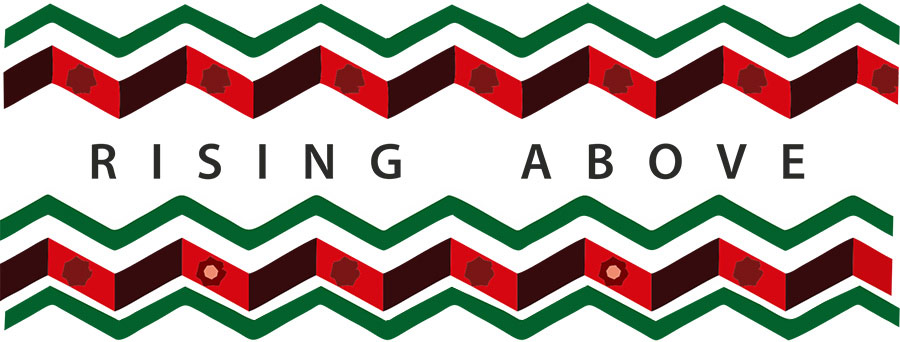
Rising Above
Hindsights of his long walk to freedom made Mandela say, “I had no epiphany, no singular revelation, no moment of truth, but a steady accumulation of thousand slights. There was no particular day on which I said that henceforth I will devote myself to the liberation of my people; instead, I simply found myself doing so, and could not do otherwise.” When and what changed his vision, his beliefs is not easy to decipher because as he said, there was no breakthrough moment for him. His awakening was gradual and he just realized it while he was constructively edging towards his goal of freedom.
It was since the year 1943 that Mandela became an active participant of the ANC’s activities and meetings. He marched for the first time with Gaur Rabede and thousands of others for protesting against the hike in bus fares in Alexandra. In the same year, he accompanied Sisulu, Oliver Tambo and other ANC officials like Anton Lembede and Peter Mde who were actively contributing to the ANC activities throughout, to Mr. Xuma’s office- the reigning head of ANC, in Sophia town. This meeting was held to propose a youth wing of ANC. The novel idea was accepted instantly and just a few hours after the meeting, this wing of ANC started functioning provisionally. It was in 1944 that the actual formation of the Youth League took place. This wing of ANC had very clear agenda and motives. They believed that no one but Africans themselves could bring back their national liberty. Their manifesto totally sidelined the notion of trusteeship. Apart from being an year of massive stride, the year 1944 also marked the occasion of Mandela’s first marriage to Evelyn Mase. Evelyn was a distantly-related cousin of Sisulu who used to reside with the Sisulu family during those times. Mandela and Evelyn had met on numerous occasions in the Sisulu House, whenever the ANC meetings took place. They had instantly grown fond of each other and this alliance resulted in their low-profile and subdued marriage.
In the following years, a number of crucial events took place that shaped Mandela’s career in one way or the other. In 1946, the great mine workers strike broke out which involved more than 70,000 mine workers who revolted against the mine’s policies of lower wages to their workers. Another restriction that came from the ruling Smuts government was that of limiting and curtailing the movement, trading and residing of Indians in some or the other parts of Africa. Both these movements were fully supported by the ANC and for Mandela, rehabilitation of his countrymen was the only motto. In the same year, Mandela moved with his wife to a more comforting neighbourhood in Orlando West. Mandela’s first son Madiba Thembekile was also born in the same year. In 1947, Mandela successfully completed his 3 year tenure as an article at Witkin, Sidelsky and Eidelman. In the same year his second child, a daughter was born. Makaziwe Mandela, also fondly known as Maki, survived for a mere nine months. Misery seemed to cling to Mandela and another misfortune came his way when a tragedy took place in ANC. It was during an informal discussion of the Youth Wing of ANC in July that Anton Lembede, the most experienced and high-spirited activist of ANC felt a chill running through his stomach and within a span of five minutes his pain worsened and made his condition critical. He was driven to the Coronation Hospital in the proximity but unfortunately, he could not survive the attack and passed away. It was a major setback for the ANC and the fellow activists.
The year 1947 was an epic year for Nelson Mandela also as in this year he formally began his services as a member of the Executive Committee of the Transvaal ANC. Impressed by his relentless work towards the betterment of ANCYL (African National Congress Youth League), Mandela was appointed as the National Secretary in 1948. This year also marked the arrival of the National Party led by the Afrikaner leader Dr. Daniel Malan. It came into power repressing the ruling United Party led by General Smuts. Although Africans were never supportive of the Smuts rule, yet, they loathed the National Party more because of its ideology that they were the real people meant to inherit the South African lands and the Blacks or Africans were a threat to their prosperity and purity. As an obvious consequence of the National Party’s victory in the General Election, the policy of ‘apartheid’ was starting to get implemented across the nation. ‘Apartheid’ which means ‘apart’ was Dr. Malan’s way of segregating the whites from the blacks. The whole country was shocked when just within a few weeks of coming into power, Malan started introducing harsh and prejudiced policies and reforms like The Mixed Marriages Act (holding the people who marry between a different race punishable), The Immorality Act (making sexual relations between whites and non-whites illegal) and The Population and Registration Act (labeling the countrymen by race and making color of their skin the sole arbiter of that individual).
At the 1949 Annual Conference, a plan of action was prepared by the Youth League on the lines of Gandhian protest in India, which advocated the weapons of non-violence like boycott, strike, civil disobedience and non-cooperation. This was accepted as the official ANC policy. Somehow, this plan did not seem right to the head of ANC, Dr. Xuma at that instance and he asked his men to revise it, but the former were too dedicated to their plan. To ensure its implementation, the membership replaced the older leaders with a number of younger men. They challenged Dr. Xuma that ANC would be supported by the young league in the presidential elections only if he gave his consent to their policies right now. Xuma did not comply and was replaced by Dr. J S Moroka, a man with a reputation for greater militancy. In the mean time, Nelsons third child, a son named Makgatho Mandela was born in 1950.
In 1952, the ANCYL decided to hold demonstrations as a measure to revolt against the prevailing government. This step was more firmly named as the Campaign for the Defiance of Unjust Laws. It was proposed to commence on the 300th anniversary of Jan van Riebeeck’s arrival to Cape Town that had initiated the progress of Africa. Jan van Riebeeck was a Dutch colonial administrator who had founded Cape Town. The date was set. The demonstrations were to hit the masses on 6th April, 1952, if the government did not pay heed to the ANC’s demands of stopping the injustice being done to the black men. A letter addressing the president, Malan, was drafted by the committee and was given the due weightage from the ANC chief, Dr. Moroka. In reply to this letter, they received a letter from the president’s office threatening them to withdraw this movement. It also stated that if ANC went against the government to create any kind of rampage, the latter will not hesitate from deploying all arms to get a hold of them. As expected, both parties were in disagreement and as a result the demonstrations began on 22nd June, 1952. On the very first day of the Defiance campaign, there were 250 people who participated in the rallies and as a result were sent to prison. In the next 5 months, people from all walks of life- doctors, lawyers, teachers, students, ministers; everyone became a part of this rebellion. Even the rural areas were not untouched by the sensational rallies that were being held far away from their proximity. During those six months of the Defiance campaign, Mandela travelled a lot. He often indulged in introducing the agendas and motives of ANC to his rural countrymen.
One more thing which Mandela took interest in during those times was his practice as an attorney and in August 1952, he started his own law firm. After the Defiance campaign broke out, Mandela and few of his co- ANC members were banned from appearing in public gatherings, meetings and any sort of appearances amongst the masses. Although Mandela did not attend many meetings during that brief period of six months, he was the one responsible for formalizing agendas and laying down the stepping stones for his party, sitting away from the lime light. Now that ANC meetings were no longer a part of his schedule, he amassed a lot of free time which he utilized for his practice as an attorney. Earlier, it was a single man initiative but very soon, a close friend of Mandela and a diligent ANC member, Oliver Tambo became his associate in the law firm. They created a new firm named ‘Mandela and Tambo’ during their ‘ban’ days.
Even after remaining far away from his full time involvement in ANCYL, Mandela and Tambo were not spared from the wrath of apartheid laws and practices. They were asked to move their work place from the city to the outskirts where the clients could not even think of reaching them. This move by the Malan Government was nothing more than a tantamount to stop the one and only independent black law firm operational in Johannesburg. However, contrary to the government’s expectations, the duo consolidated their thoughts and initiatives to go against the rules for the liberty of their countrymen.
In 1953, Mandela was given charge of preparing the M-plan named after him. This was a plan that would enable the leadership of the ANCYL movement to maintain dynamic and ongoing contact with its group members without their actual presence in public meetings. The devious objective of this plan was to be declared illegal. The ANCYL was working towards the goal of getting stamped as an illegal organization like The Communist Party so that they could operate underground with more liberty. Although the plan was devised with the best intellect and intentions but its adaptation was not fulfilling. The effect was scattered and it became unable to hit the government, as was required at that time. Between these ups and downs of the ANCYL, Mandela was blessed with a daughter, whom the couple named Makaziwe Mandela, in honour of their first daughter.
1950’s were terribly tough for mandela. He had to go through a lot of hardships in his political career that he considered as his only component of life during those days. Apart from the political trauma growing with Malan’s policies incubating day after day, the thing that hit Mandela straight in his heart was his divorce with Evelyn Mase, his first wife. From early 1953, the crater between Mase and Mandela had started deepening. She had always assumed that Mandela would eventually quit politics and get back to his country life style and that politics was nothing more than a ‘youthful diversion’ in his career path. But to her disdain, Mandela breathed, spoke and lived politics. Their views and thoughts on general family matters like the upbringing of their children started differing and they always found each other opposing and quarreling. They were aware of the fact that their brawls were waging innumerable battles in the minds of their children too. Finally in 1955, Mase confronted Mandela with all her concerns about their deteriorating relationship and asked him to choose either her or politics. Needless to say, Mandela chose his duties over his family.
The Trial of the Toughest- ‘Treason’
It was on that dreaded dawn of 5th December, 1956, that Mandela was arrested by the South African police under the charges of treason. Treason was the most unformidable crimes to be carried out in a hostile nation. Any act of patriotism or nationalism could be accounted as fanatics and the person or group in charge could be arrested as guilty of propagating terrorism within the nation for selfish reasons. The ANC was completely aware of this swoop played out by the government. Within the next 168 hours, other allies of Mandela were also under arrest. There were a total of one hundred and fifty six political prisoners including eleven senior activists like Walter Sisulu. All of them were soon moved to Johannesburg Prison, popularly known as the Fort. Mandela had sarcastically pointed out in the past “it is said that no one truly knows a nation until one has been inside its jails and South Africa treated its imprisoned African citizens like animals.”They were detained in the Fort for two more weeks during which they successfully converted their communal cell into a convention for the freedom fighters. What came as an opportunity in adversity was, that ANC supporters from different parts of Africa were coming in together at the Fort and the place became more like a hub for the delivery and exchange of ideas and visions.
On December 19, the charged were taken at the Drill Hall in Johannesburg for their trail. They were all accused guilty for their participation in countrywide conspiracy generating movements like the Defiance campaign. If the alleged were found guilty, their punishment would be death. The trial kept continuing day after day and on the fourth day, the prisoners were provisionally released on bail. But like everything else in Africa, even the treason bail was a racist! There was a different price fixed for the release of prisoners of every race with whites being the highly priced, then the Indians and finally the invaluable creed- Coloureds and Africans.
On January 9, 1957, the guilty appeared in the Drill Hall again; only now, it was the defense’s turn to refute the state’s charges. But like every other discrepancies done to the blacks, the trial became the most slithering thing to happen. Months and months passed by and the decision would never get announced. To increase the difficulties of the alleged, the state asked them to produce a total of 12,000 bytes of evidence. Finally, after seven months of court trial, charges against sixty accused were dropped. The names of the freed included Oliver Tambo too, which came as a ray of hope for the ANC.
After his bail, Mandela reached home to find it vacuumed. Mase had left along with the kids and in 1957, after four children and 13 years of marriage, the couple divorced. Mase could no more take his absence at home and his devotion to revolutionary agitation. Another fact was that she was a Jehovah’s Witness, a religion which requires political neutrality. Mandela later found out that the kids were blown off to a great extent due to this separation. The worst hit of all was his son Thembi who was just 10. Many years later, Mandela remembers how his beloved son had withdrawn from his studies in the process of adapting to his father’s approximate loss.
In the year 1958, Mandela came across Nomzamo Winifred Madikizela, more often referred to as Winnie. Winnie was the first black female social worker at Baragwanath Hospital. She and Mandela had first met to resolve some legal matters concerning Winnie’s family but it was apparent from their elongated conversations and their recurrent meetings that they were getting fond of each other.
The Treason Trial had stretched onto its second year and was making it difficult for Tambo and Mandela to practice. But even after suffering the financial turmoil, Mandela decided to marry Winnie in the most precise, formal manner as a marriage is supposed to be in the Thembu tribe. The wedding took place on 14th June, 1958, and Mandela received a relaxation of six days from his ANC ban for the same. Their first daughter Zenani was born the very next year in 1959.
On 3rd August, 1959, after an ordeal of two years and eight months, all the accused, including Mandela were declared non-guilty and freed from all the charges that were built against them. Meanwhile, the only consequential thing to happen was the government’s approval of the Promotion of Bantu Self-Government Act that segregated the whites and blacks more distinctively and brutally. Owing to this fact, there were a number of protests that erupted in various parts of Africa like Pondoland and Thembuland and a lot of ANC supporters were killed. The agitation among the people had risen so high that a new organization called the PAC (the Pan-Africanist Congress) came into being. Although the manifesto and motives of the PAC were not too different from that of the ANC, it succeeded in easing out the application of apartheid for the government at large as many of the ANC supporters had now acquitted to the PAC, leaving ANC weak and confused.
Zindzi , Nelson’s second daughter was born in 1960, the only good thing that took place that year. The year 1960 was a particularly cursed year for Africa as its memoirs transported the Africans back to the Sharpeville massacre. Sharpeville was a small locality chosen by the PAC activists to conduct demonstrations against the growing dictatorship of the government. The PAC comrades were peaceful in their conduct and all of them were indiscriminatingly unarmed. However, in a spur of the moment during their protest, the police opened fire on the helpless defenseless protesters. The legal riot took as many as 69 innocent lives and injured more than 400 South Africans.
This disaster brought along a series of results that just built on the trepidation in the African states. The stock markets plunged and the emigration counts kept on rising. Even the white natives were afraid of staying in Africa. The matters became so worse that United Nations Security Council intervened in the African government’s affairs and criticized it greatly for their unorganized rule. There were a lot of anti-apartheid movements and demonstrations as an aftermath of this mournful happening. The ANC chief publically proposed a nationwide stay-at-home protest to denounce the government. On 28th March, miraculously, a crowd of over fifty thousand Africans gathered in Cape Town in support of the deceased. But as a result, the government turned as devious as it could get; a state of Emergency was declared and sweeping powers against all forms of subversion were granted to the police.
As a very obvious remedy to this situation, the government started amassing all the troublemakers and Mandela was no exception. On 30th March, he was arrested without a warrant as a political criminal, along with the other members of PAC and ANC. All the accused were made to live in terrible conditions while they were detained. Firstly, they were kept devoid of food and water for 18 hours after they were imprisoned and secondly, the cells and the so called basic amenities like sanitation, food and clothing were in such a filthy and foul state that one would want to give up using those resources had they not been extremely vital for sustenance. Soon after this arrest, in a week’s time, both ANC and PAC were declared as illegal organizations under the suppression of communism Act. This trauma continued for one whole year until the Emergency was lifted. On 29th March, 1961, it was finally declared in the trial that ANC officials were not guilty and as a result, all the arrested were discharged. This day was rejoiced like a day of victory in Africa when the beloved freedom fighters of the country were freed from all the shackles of the government.
After the release, ANC and Mandela became more cautious regarding their alternatives to finding ways and means to acquire freedom. Mandela remained underground for most part of the early 1960s. He was forced to live apart from his family as he was always on a move and had to adopt a number of disguises. He was a labourer in one instance, a chauffeur in another and a gardener in the next. His successful attempts at fooling the police every time, earned him the title of “the Black Pimpernel”. It was during this time that he, together with other leaders of the ANC thought of taking a fateful step in context of the ANC and the South African history. Since 50 years till the 1960s, non-violence was the core driving principle of the ANC, but with the rising atrocities of the government, the ANC decided that henceforth, it would be recognized under a different light. The ANC then adopted the path of organized violence. It constituted a new section of the liberation movement, Umkhonto we Sizwe (the spear of the nation) or MK, as an armed wing of ANC, with a view to prepare for armed struggle with Mandela functioning as its commander-in-chief. Mandela recalls in his autobiography, “I, who had never been a soldier, who had never fought in a battle, who had never fired a gun at an enemy, had been given the task of starting an army.” While planning for the direction and shape that MK would take, Mandela and the rest of the ANC agreed upon four types of violent activities- sabotage, guerilla warfare, terrorism and open revolution. While performing the deeds of destruction, leaflets including the details of the birth of MK were also circulated at varied junctures. They spoke about their activities and carried out organized attacks on government bodies particularly those who had greater and deep rooted connections with the apartheid policies. The most effective move carried out successfully by the MK was the Dingane’s Day explosions. The date was 16th December, 1961, and the whites, were celebrating the triumph of the Afrikaners over the Africans. The explosions that happened on that day took the African government by total shock.
Such a high risk involved action from any anti-government organization was never expected. Soon after this mighty first blow, came the second round of explosions on the New Year’s Eve.

In early 1962, Mandela left the country under the pseudonym ‘David Motsamayi’ and travelled abroad for several months. He attended and addressed various political gatherings and meetings during that time in Ethiopia and Central Africa and was appreciated by the senior political leaders in several countries like Tanganyika, Senegal, Ghana and Sierra Leone. He also spent time in London where he was united with many exiled comrades including Oliver Tambo, his closest and most trusted friend over the years. During this time, Winnie, Mandela’s second wife was facing a tough time coping with the unalarmed and untimely visits of the cops at her home relentlessly questioning her about the track of Mandela’s escape. Finally, in the August of 1962, Mandela decided to let his guard down and reached Johannesburg. As clear as it was, the police had sealed every corner of the places where Mandela was suspected to visit once he reached back in town and it was on August 5, 1962 when Mandela was once again arrested.
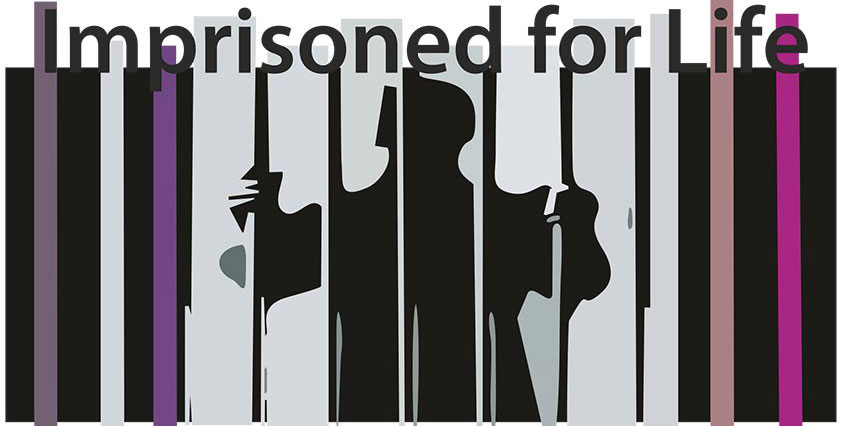
Imprisoned for Life
Since Mandela considered the prosecution an assessment of the aspirations of the African people, he decided to fight himself for his defense. He applied for the deposing of the magistrate, because he considered him to be partial, being a servant of the white government. As a result, Mandela was convicted and sentenced to five years imprisonment. He was transferred to Robben Island in May 1963.
Mandela believed that“prison not only robs you of your freedom, it attempts to take away your identity. As a freedom fighter and as a man, one must fight against the prison’s attempts to rob one of these qualities.” As a man guided by his defiance and individualism, Mandela oppressed numerous laws and codes as a criminal under arrest too. Initially, he denied wearing shorts as the uniform on Robben Island as he believed that he was a Political prisoner and the latter were supposed to be treated with a little deference, even though in jail. He was strong headed about his conditions right from the beginning and although compromising at one or the other situation, he managed his stay in the prison commendably.
In October 1962, the ANC conducted its first annual conference after almost four years and herein the ANC and the MK were explicitly linked to be recognized henceforth as a singular entity. The activities on both the sides were getting more and more outrageous and tragic. If the ANC was displaying a scene of consolidated battle preparations, the government too was ready with diffusers to burn out the formers light. On 1st May, 1963, the government introduced much stricter apartheid laws. It brought on The Ninety Days Detention Law which gave any police officer the right to detain any person without a warrant on the grounds of being a suspect of any political crime. Soon after these reforms, the news regarding the savage treatment of prisoners started flowing in from different parts of Africa. The prisoners were reportedly victimized of electric shocks, suffocation and other forms of inhumane tortures.
Towards the end of May, Mandela along with some other prisoners was brought back to Pretoria. The authorities issued a statement citing the reason for Mandela’s shift as a means to protect the latter of the PAC assaults in the Island but it was clear to all that the government had its own selfish motives in bringing him back. They needed to keep him isolated so much that even his breathing could not communicate any kind of message to anyone.
On October 9, 1963, Mandela along with the other prisoners was taken to the Palace of Justice in Pretoria for what came to be known as The Rivonia Trial. Unlike the Treason Trial, this time the accused were charged of sabotage and conspiracy. The trial kept on continuing with evidences being brought in by both the state and the defense. Almost every accused stood up well to the prosecution and took the opportunity to make the public aware of their political beliefs and motives. After a long wait of almost eight months, the verdict for The Rivonia Trial was decided to be declared on 12th June, 1964. Three of the accused, Mandela, Sisulu and Govan Mbeki were adamant on the decision that whatever the verdict be, they will not appeal to the superseding courtroom, even if it were a death penalty. When Mandela had his last say in the courtroom in his own defense, his words were, “I have fought against white domination, and I have fought against black domination. I have cherished the idea of a democratic and free society in which all persons live together in harmony and with equal opportunities. It is an ideal which I hope to live for and to achieve. But if needs be, it is an ideal for which I am prepared to die.” But as the verdict was announced, every African breathed a sigh of relief as the accused were not given a death penalty but life imprisonment.
The 46 year old Nelson Mandela was deported back to Robben Island where he spent 27 years of his life in prison. When Mandela had his first experience of the Robben Island in 1962, it was still an under development cage but this time the scenario was entirely different. The place had transformed into the most harshest and stern outpost in the African penal system. While the idea of being desolated and cut out from the world even for an hour or two snatches the life out of us, Mandela was parted away from all his comrades, his family and his countrymen for 27 long years. It would be unfair and false to say that there were no moments of despair and contemplation for him. There were times when his perseverance and honesty were sorely tested by the surroundings he was living in and the conditions that he was put through. But being a man of epitomized pride and optimism, Mandela chose not to succumb. He recalls his experience in the Robben Island as the darkest part of his life but even there he remained too proud and legitimate to give up and accept defeat.
Life in Robben Island was an ordeal inside out. The work schedules of the prisoners were very disciplinary and the punishments of overlooking or not abiding by the state laws were unimaginably appalling. Even in prison, the criminals were grouped into the categories A, B, C and D to maintain a hierarchy amongst them. As a group D prisoner, Mandela had acquired the right to have only one visit, write and receive only one letter during a period of six months. While he was in prison, Mandela had to face a lot of adversities including the grievances that were non-political and losses that were irrevocable.
In the spring of 1968, Mandela was paid a visit by his mother in the Robben Island. An instance when the freedom fighter realized the effect of time and age on the life of people not in prison. His mother, as Mandela later recalls had become haggard when she visited him. He knew that he was the partly the reason behind her ill-health. As a mother, she was genuinely tensed for her always chased and now imprisoned, trouble- making son. A few weeks later Mandela was informed by a telegram at the head office that his mother had passed away. He tried all means to get a bail to go and arrange for his mother’s funeral- the utmost duty of a son; but being a repulsive prisoner, his plea was denied.
Later in 1969, Mandela got the news of his wife being arrested without warrant under The Terrorism Act. All the bad news that were piling in from different spheres of his life were getting too hard to process when the most devastating loss was intimated to Mandela. He received a telegram from his youngest son Makgatho telling him in just one statement that his eldest son Thembi had died in a car crash. This tragedy was just too much for even a strong man like Mandela to get over with.

Years went by and even as a prisoner, Mandela tried all resorts to bring the ANC back in action after his release. He would often find opportunities to resolve the differences between the ANC and PAC inmates to bring them together and stand firmly against the bigger evil – the government. While in prison, Mandela fearlessly discarded offers made by his supervisors for lessening of sentence in exchange for complying with the Bantustan policy. At yet another instance in the 80’s, Mandela and others rejected an offer of their freedom on the condition of surrendering violent practices. To this proposed exchange, he blatantly responded “Prisoners cannot enter into contracts – only free men can negotiate.”
Mandela was still in prison when his daughter Zenani was married to Prince Thumbumuzi Dlamini in 1973, elder brother of King Mswati III of Swaziland. South African authorities did not permit her to visit Mandela.
In March 1982, after 18 years, Mandela was transferred to a single cell at Pollsmoor Prison in Cape Town. One thing that Mandela always worked towards was the betterment of the nation and upliftment of his countrymen. Therefore, he did initiate talks with the apartheid regime in 1985, when he wrote to the Minister of Justice, Kobie Coetsee. From here, Mandela began a round of negotiations with the government – more appropriately understood to be as the ‘talks about talks’. Subsequently, in December 1988, Mandela was moved to the Victor Verster Prison near Paarl, from where he was eventually released. In 1989, Mr. De Klerk, member of the Nationalist party became the President of the South African republic. Klerk was not only a man of his own rules but also a pragmatic and thoughtful leader. He knew that at this critical juncture change was not only necessary but also inevitable. Soon after he became the president, things started changing. The ANC members, including Walter Sisulu and several others, were released from their imprisonment. Also, Klerk took the initiative of dismantling the prevalent severe apartheid laws in his attempt to restore humanity and liberty nationwide. For this, Mandela sent a letter of appreciation and regard to Klerk.
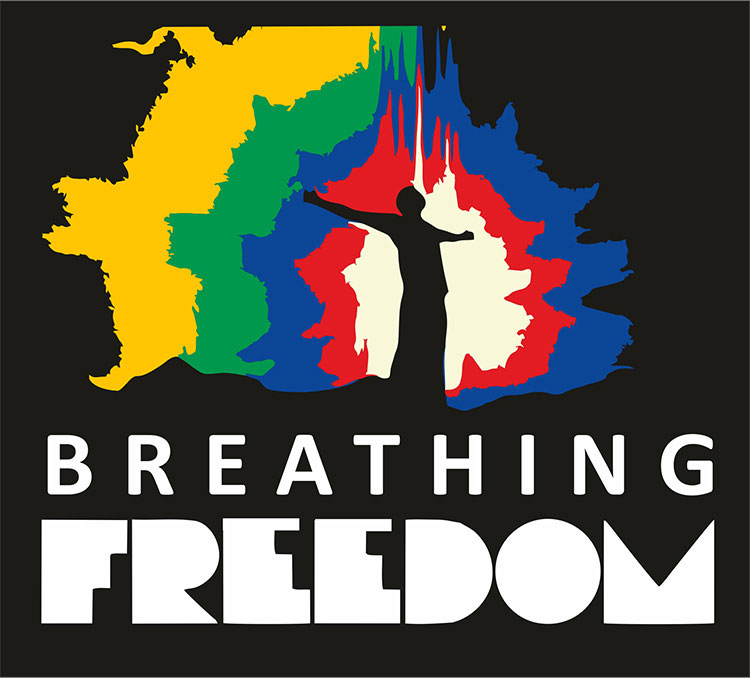
Breathing Freedom
At 3.30 pm on February 11, 1990, Mandela was released free of all the charges and cases filed against him.

He greeted his fellow countrymen with utmost warmth and great words. He said,“Friends, comrades and fellow South Africans. I greet you all in the name of peace, democracy and freedom for all! I stand before you not as a prophet but as a humble servant of you, the people. Your tireless and heroic sacrifices have made it possible for me to be here today. I therefore place the remaining years of my life in your hands.” As dedicated as these words sounded, Mandela worked inexorably to accomplish all those targets that he and others had set out in the beginning of this much extended movement of pride, justice and liberty. In 1991, the first national conference of the ANC was held and Nelson Mandela was elected the President of ANC while his lifelong friend and colleague, Oliver Tambo, became the organization’s National Chairperson.
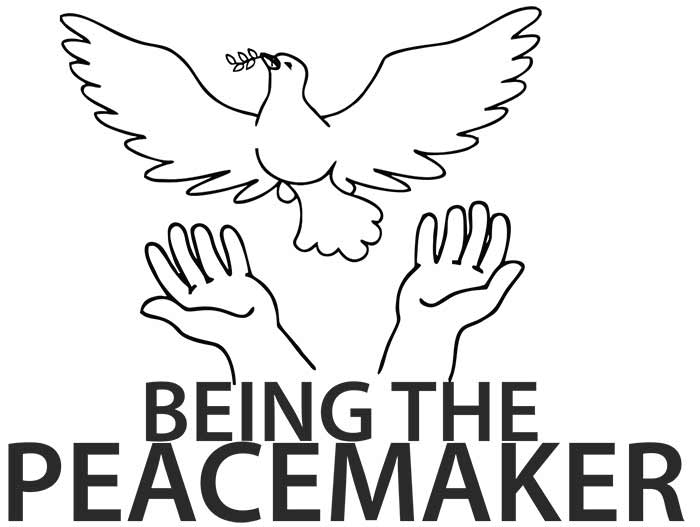
Being the Peacemaker
Mandela’s life that involved continuous trial of the undying human spirit became the road map of life for many young achievers to come. With due pride and glory, Nelson Mandela accepted the 1993 Nobel Peace Prize for all those South Africans who suffered and sacrificed but still stood by him and his ideologies at the most critical of all situations.

The era of the vicious apartheid officially ended on April 27, 1994, when Nelson Mandela voted for the first time in his life – along with his people- the whole nation. Rolihlahla Nelson Dalibunga Mandela was inaugurated as President of a democratic South Africa on May 10, 1994.
In his inauguration speech he said:
“We are both humbled and elevated by the honour and privilege that you, the people of South Africa, have bestowed on us, as the first President of a united, democratic, non-racial and non-sexist government. Let there be justice for all. Let there be peace for all. Let freedom reign.”
Meanwhile, on the personal front, due to political estrangement his marriage with Winnie ended in March 1996. Mandela married for the third time, on his 80th birthday, July18,1998. He married Graca Machel, widow of Samora Machel, the former Mozambican president and ANC ally who was killed in an air crash 12 years earlier.
Mandela relinquished his presidency in 1999 after his singular term as President – but there has been no retirement for this man. He set up three foundations bearing his name: The Nelson Mandela Centre of Memory, The Nelson Mandela Children’s Fund and The Mandela-Rhodes Foundation. His schedule was jam packed over the years, raising money for his foundations to build schools and clinics in South Africa’s rural heartland, and serving as a mediator in Burundi’s civil war. He also published a number of books on his life and struggle, the most popular among them being: No Easy Walk to Freedom; Nelson Mandela: The Struggle is my Life; Nelson Mandela’s Favourite African Folktales. In 2001 he was diagnosed and treated for prostate cancer.
In June 2004, at the age of 85, Nelson Mandela announced his formal retirement from all the offices and his public life. He returned back to his native village Qunu and adopted the lifestyle of his tribe as he was supposed to do long back. But as they say, “destiny never retaliates its plans with you”, so was his destiny that he transited to becoming the iconic personality of world peace. In 2005 after his son’s death due to AIDS, Mandela committed himself to the cause of fighting against the same. Later, on July 18,2007, Mandela assembled a group of world leaders, including Graca Machel, Desmond Tutu, Kofi Annan, Ela Bhatt, Gro Harlem Brundtland, Jimmy Carter, Li Zhaoxing, Mary Robinson and Muhammad Yunus and formed a group called “The Elders“. This assemblage was committed to working publicly and privately to find solutions to problems around the globe. Since its initiation, the group has made an impact in Asia, the Middle East and Africa, promoting peace and women’s equality, demanding an end to atrocities, and supporting initiatives to address humanitarian crisis and promote democracy.
Mandela made his last public appearance in the 2010 Cricket World Cup in South Africa. He also met the American first lady on her trip to South Africa in 2011. At the age of 94, in 2012, the peace maker was said to be having a recurrent problem of infectious lungs for which he was hospitalized in early December 2012. He is now retired, but not without leaving something to ponder; according to a statement on his website
“Mr. Mandela gave 67 years of his life fighting for the rights of humanity. All we are asking is that everyone gives 67 minutes of their time, whether it’s supporting your chosen charity or serving your local community.“
Although his struggle as a black born continued for a greater part of his life, Nelson Mandela never judged or discriminated any white organization or individual. He never compromised his devotion to democracy, equality and learning. Despite terrible provocation, he never became a racist. Even in the matters concerning the protection of his life, he trusted whites with complete faith and sincerity. His life has been an inspiration not only to the people in South Africa but throughout the world. Knowing him makes you realize that no darkness is too dark to succumb your faith and courage to. There will always be a ray of hope; you just need to strive long enough to find it glowing.
Next Biography





